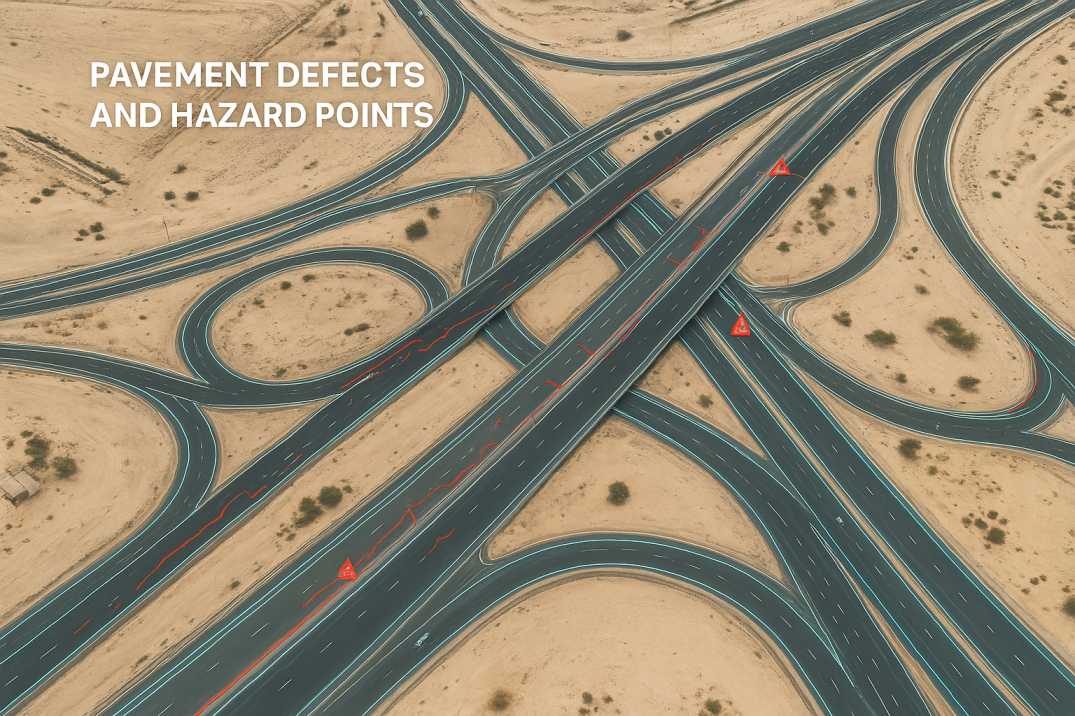Contact Us
RoadVision AI
Private Limited
Office No. 308 & 310, B Block
Ansal Chamber - 1, Bhikaji Cama Place,
Near Engineers India Limited (EIL) Bhawan, New Delhi - 110066
© 2024 | RoadVision AI | All rights reserved
Qatar is at the forefront of building safe, efficient, and sustainable road networks. With its rapid urban growth and significant investments in infrastructure, ensuring road safety has become a top priority under the Qatar National Vision 2030 and the Qatar Road Safety Strategy (Q-RSS).
The integration of AI-powered road asset management Qatar solutions, predictive road maintenance, and digital road maintenance systems is revolutionizing how authorities conduct road safety audits and hazard prevention. Leveraging technologies like automated pavement condition surveys and smartphone-based road surveys not only improves safety outcomes but also optimizes operational costs.

A road safety audit is a systematic process to evaluate the safety performance of existing roads and new projects. According to the Ministry of Transport (MOT) and the Public Works Authority (Ashghal), Qatar mandates safety audits for major road projects to identify and mitigate hazards before accidents occur.
Traditional audits relied heavily on manual inspections, which could be time-consuming and prone to human error. Today, Qatar’s road sector is embracing AI-driven road safety audits that detect hazards faster and more accurately, supporting the country’s goal of achieving zero fatalities under the Qatar Road Safety Strategy.
Road asset management Qatar is transitioning from reactive to predictive models. By using AI algorithms, large volumes of road condition data are processed to identify early signs of deterioration. This data-driven approach enables predictive road maintenance, which minimizes costly repairs and prevents safety hazards before they escalate.
AI systems integrate with GIS mapping and IoT-enabled sensors to monitor critical assets, including pavements, guardrails, traffic signs, and lighting systems. This holistic approach ensures that every asset in the network remains functional and safe.
Predictive road maintenance in Qatar uses real-time monitoring combined with historical deterioration patterns to forecast when maintenance should be performed. This approach aligns with the MOT’s vision for sustainable infrastructure management.
A key enabler is the automated pavement condition survey, which uses AI-equipped survey vehicles and high-resolution imaging to detect cracks, rutting, potholes, and surface distress. The results are processed instantly, generating actionable maintenance plans that align with the digital road maintenance system in place.
This not only extends the lifespan of road assets but also reduces disruption to road users.
For municipalities and contractors, smartphone-based road surveys are an affordable yet powerful method to collect road condition data. Using accelerometers, GPS, and AI-powered mobile applications, inspectors can record road roughness and detect anomalies while driving at normal speeds.
This innovation supports smaller-scale projects and provides supplemental data to large-scale automated surveys, making it an ideal solution for local councils across Qatar.
Qatar’s digital road maintenance system integrates various technologies — AI, GIS, IoT, and big data analytics — to create a unified platform for road health monitoring.
By centralizing condition data, authorities can prioritize maintenance, allocate budgets effectively, and plan preventive interventions. The system also ensures compliance with Qatar’s national road safety standards and supports transparency in infrastructure planning.
Explore more on Traffic Surveys.
Hazard detection is no longer reactive. AI systems now identify hazards such as missing signs, debris, faded lane markings, poor drainage, and surface defects in near real-time. The technology uses deep learning models trained on thousands of road images to flag potential issues before they cause accidents.
Integrating hazard detection into a road asset management Qatar strategy ensures that risk mitigation becomes proactive rather than reactive.
See how AI is shaping the industry in our Case Studies.
Qatar’s adoption of AI-powered road asset management, predictive road maintenance, and digital road maintenance systems is setting a new benchmark for safety and efficiency. By integrating automated pavement condition surveys, smartphone-based road surveys, and AI-based hazard detection, the country is on track to achieving its ambitious road safety goals.
RoadVision AI is leading innovation in AI in road maintenance, providing a smart, automated solution for managing road networks. It conducts detailed traffic surveys and generates high-quality road data for early detection of issues such as surface cracks and the need for potholes repair. This technology-driven platform brings the power of AI in road planning and monitoring to enhance road safety. With a mission to create smarter, safer, and more sustainable roads, RoadVision AI ensures full compliance with IRC Codes as well as Qatar’s road design and maintenance standards set by Ashghal and MoTC.
To learn how your organization can benefit from these solutions, book a demo with us.
Q1: What is the main purpose of a road safety audit in Qatar?
It ensures road designs and existing infrastructure meet safety standards and reduces the risk of accidents through proactive hazard identification.
Q2: How does predictive road maintenance work?
It uses AI algorithms to forecast asset deterioration and schedule maintenance before defects become severe.
Q3: Can smartphone-based road surveys replace traditional methods?
They can complement traditional surveys, providing a cost-effective way to collect additional road condition data.